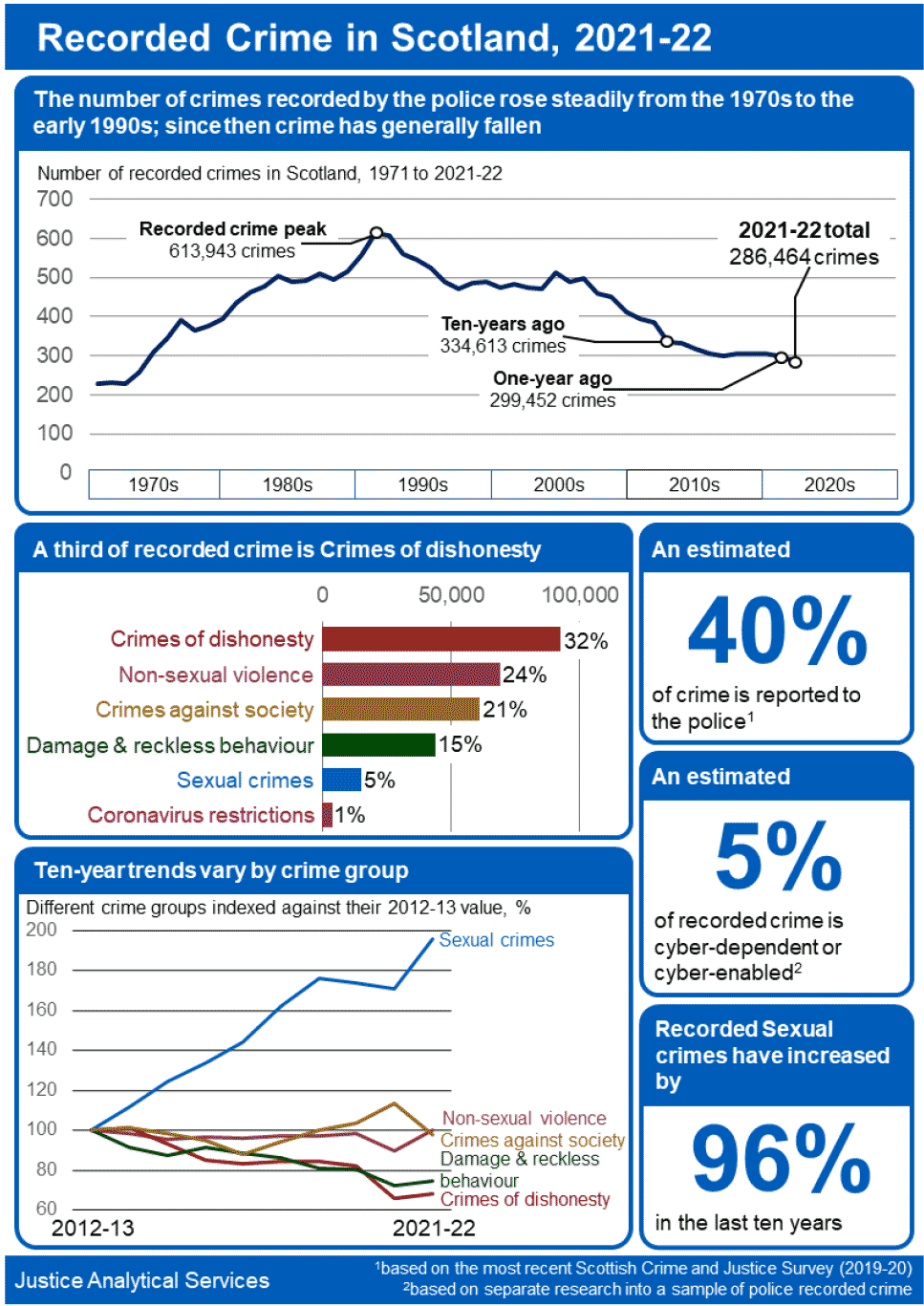Recorded Crime in Scotland, 2021-2022
Statistics on crimes and offences recorded and cleared up by the police in Scotland in 2021-22, split by crime or offence group and by local authority.
Key points
Between 2020-21 and 2021-22:
- Crimes recorded by the police in Scotland decreased by 4%, from 299,452 to 286,464. This fall was driven by a 81% reduction in crimes recorded under Coronavirus related legislation (from 20,976 to 3,913). All other crimes collectively increased by 1%. The recording of crime is at the lowest level seen since 1974.
- Non-sexual crimes of violence increased by 12%, from 61,913 to 69,286. This was driven by a rise in Common assault (also up 12%), which makes up the clear majority (84%) of all Non-sexual crimes of violence recorded in 2021-22.
- Sexual crimes increased by 15%, from 13,131 to 15,049. These crimes are now at the highest level seen since 1971, the first year for which comparable groups are available.
- Crimes of dishonesty increased by 4%, from 89,731 to 92,873. The recording of these crimes is at the second lowest level seen since 1971.
- Damage and reckless behaviour crimes increased by 3%, from 42,964 to 44,284. The recording of these crimes is at the second lowest level seen since 1976.
- Crimes against society decreased by 14% from 70,737 to 61,059. Most of these crimes relate to drug possession, crimes against public justice or weapons possession (used and not used).
Offences recorded by the police in Scotland collectively decreased by 3%, from 187,233 to 180,913. This included a reduction in Antisocial offences (down 3%), Miscellaneous offences (down 5%) and Road traffic offences (down 4%).
Police recorded cyber-crime in Scotland
This bulletin also provides an updated estimate of how many cyber-crimes were recorded in Scotland.
Key Points:
- In 2021-22, an estimated 14,280 cyber-crimes were recorded by the police in Scotland. This is similar to the estimated 14,860 cyber-crimes recorded in 2020-21, but remains a large increase compared to the estimated 7,710 cyber-crimes recorded in 2019-20.
- Part of the increase since 2019-20 may be due to the significant impact of the COVID-19 pandemic, including behavioural changes such as increased online shopping.
- Cyber-crimes accounted for an estimated 28% of Sexual crimes in 2021-22, 9% of Crimes of dishonesty and 3% of Non-sexual crimes of violence.
Official Statistics on Clear up rates
In addition to the National Statistics on police recorded crimes and offences, this bulletin also presents Official Statistics on crimes and offences cleared up by the police in 2021-22. A definition of clear up rates is provided in the clear up rates chapter.
Crimes recorded under Coronavirus related legislation are excluded from these statistics, as a bespoke and separate data collection is used by the police to capture these cases.
In 2021-22 the clear up rate was 54.0%, down from 59.3% in 2020-21, and similar to 54.9% in 2019-20. The increase in 2020-21 likely reflected the impact of the COVID-19 pandemic on the types of crime recorded, with the volume of those crimes that have relatively lower clear up rates falling more sharply than those with relatively higher clear up rates.
The fall back to 54.0% in 2021-22 reflects a partial return to the volume of different crime types recorded in the year prior to the pandemic (2019-20), albeit clear up rates have still fallen for each of the individual crime groups. This included Non-sexual crimes of violence (down from 72.1% to 67.1%), Sexual crimes (58.4% to 53.5%) and Crimes of dishonesty (37.9% to 31.6%).

The number of crimes recorded by the police rose steadily from the nineteen-seventies to the early nineteen-nineties; since then crime has generally fallen. Comparable records began in 1971, with recorded crime peaking in 1991 at 613,943 crimes. Ten years ago there were 334,613 recorded crimes and one year ago there were 299,452 recorded crimes. In 2021-22, 286,464 crimes were recorded.
A third of recorded crime is Crimes of dishonesty. In 2021-22, recorded crime consisted of 32 percent Crimes of dishonesty, 24 percent Non-sexual crimes of violence, 21 percent Crimes against society, 15 percent Damage and reckless behaviour, 5 percent Sexual Crimes and 1 percent Coronavirus restrictions.
Ten-year trends vary by crime group. Recorded Sexual crimes have almost doubled between 2012-13 and 2021-22. Between 2012-13 and 2021-22 recorded Non-sexual crimes of violence fell slightly before returning to almost the same level. In the last ten years the volume of recorded Crimes against society has largely held steady. Both Damage and reckless behaviour and Crimes of dishonesty have decreased between 2012-13 and 2021-22.
An estimated 40 percent of crime is reported to the police. This figure is based on comparisons with data provided in the most recent Scottish Crime and Justice Survey (2019-20).
An estimated 5 percent of crime is cyber-dependent or cyber-enabled. This figure is based on separate research into a sample of police recorded crime.
Recorded Sexual crimes have increased by 96 percent in the last ten years.
Contact
Email: Justice_Analysts@gov.scot
There is a problem
Thanks for your feedback